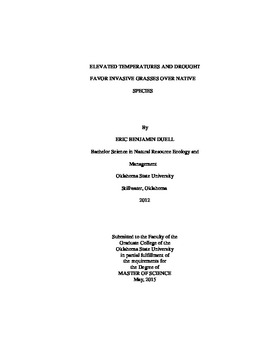| dc.description.abstract | Projected global-scale anthropogenic alterations to native ecosystems include intense and prolonged droughts, increases in atmospheric temperatures, and invasion by non-native species. Understanding how native and non-native grasses tolerate drought and elevated temperatures is essential for projecting native species competitive success. We assessed the effects of elevated temperature and drought on the performance of different growth stages (seed, seedling, and mature plant) of invasive grasses, relative to native species. Further, we determined responses of warm- and cool-season functional groups. The invasive warm�season cespitose grass, Bothriochloa ischaemum) was paired with functionally similar native Schizachyrium scoparium. The invasive cool-season grass, Bromus inermis, was paired with functionally similar native Pascopyrum smithii. We assessed each growth stage at ambient [warm-season (24� C); cool-season (17� C)] and elevated [warm-season (29� C); cool-season (22� C)] temperatures. Seeds were maintained under three water-availability treatments (100%; 83.5%; or 65% field capacity). Seedlings of each species were maintained under for 14 weeks at well-watered (100% field capacity) and extreme drought (65% field capacity). Mature individuals of each species were maintained for 14 weeks at well-watered (100% field capacity) and extreme drought (65% field capacity), as well as two intermediate soil moisture levels (85% and 75% field capacity). Generally, invasive species from each functional group surpassed the corresponding native in germination, biomass production, and re-growth at all climatic conditions. Because associations with AM and saprophytic fungi may aid in host water acquisition and thermal tolerance, we hypothesized these fungal groups would be relatively more abundant when plants were exposed to adverse conditions. However, few differences were apparent between soil microbial communities (i.e. total microbial biomass, or relative abundance of AM or saprophytic fungi) of either native or invasive grass species in response to adverse environmental conditions. Our results indicate invasive perennial grasses are competitively superior to functionally similar native species at all life stages, under ambient and extreme temperature and drought. As more intense and frequent droughts, coupled with elevated temperatures, are projected for grasslands worldwide, our data suggest invasive grasses will out-compete native species at potentially greater magnitudes than currently observed. | |
